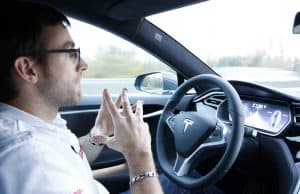Rear-end collisions are some of the most common motor vehicle accidents on California roads. Rear-end collisions often leave accident victims—particularly those in the lead car—with severe, long-lasting injuries. If you have suffered any injuries than speak to an experienced San Diego Car Accident Lawyer. Some of the more common rear-end collision injuries include whiplash, spinal injuries, brain injuries, orthopedic injuries, lacerations, abrasions, burn injuries, and secondary injuries.
What Happens in a Rear-End Collision
To understand the injuries typical of a rear-end car accident collision, it helps to examine the mechanics of these accidents.
In the typical rear-end collision, a leading car is stopped or moving slowly when a faster-moving trailing car collides with the leading car’s rear end. The impact accelerates the leading car and slows down (or decelerates) the trailing car. Think, for instance, what would happen if a moving car slams into the back of a car stopped at a light. The stopped car will suddenly jolt forward, while the rear car will come to a rapid stop as a result of colliding with the lead car.
The driver and passengers of both cars may sustain injuries. However, the occupants of the lead vehicle have a higher risk of harm. This is because car manufacturers typically prioritize safety features that protect passengers when their care rapidly slows down (such as when the car hits an object and comes to an abrupt stop). These safety features provide little protection for when a car rapidly speeds up (after being hit from behind at high speed). If you or a loved one has already been involved in a rear end accident consider seeking compensation from Gomez Trial Attorneys.
Whiplash Injuries Are Common
Whiplash is the most common of all injuries inflicted on occupants of the lead car in a rear-end collision. This injury results directly from the sudden, rapid, and often-violent acceleration, and subsequent deceleration, associated with these accidents. Here’s how it occurs.
The lead car in a rear-end collision accelerates in a fraction of a second, then (usually) slows down almost as abruptly. Everything inside the car also speeds up and slows down, including the vehicle’s occupants. But not every part of a human body accelerates and decelerates at the same time. Specifically, in that split second, a person’s torso shoots forward but the person’s head and neck, which have their own inertia, lag slightly behind.
Research shows that because of this independence of movement between the torso and the head and neck, the spine absorbs and transmits the force of the impact upward the way a bow travels up a bullwhip until its tip goes snap. This so-called shearing force causes the head of the car’s occupants to snap in the same way.
Depending upon the force of the accident, the posture of the lead car’s occupants, and the design and placement of the headrests in the lead car (to name just a few factors), this whipping action can exert extreme strain on the soft tissue and structures in the neck, causing significant damage. The symptoms of whiplash include soft tissue pain, headaches, and a limited range of motion.
Often, we see the term “Whiplash” used inaccurately used in pop culture to describe minor neck pain, and as a result, is often believed to be a less serious injury. In reality, whiplash is painful and debilitating. It can lead to chronic, long-term complications and disabilities. While some cases of whiplash will heal in time, others linger or lead to secondary health conditions. Doctors may treat whiplash by partially immobilizing the head and neck, and prescribing massage or ultrasound therapy.
Victims of a rear-end collision should never assume they have escaped a whiplash injury simply because they do not feel immediate pain after an accident. Whiplash symptoms tend to appear hours or days after the initial trauma. The damage whiplash inflicts, however, can appear on diagnostic tests even before the worst of the pain sets in. After a rear-end collision, seek appropriate medical care as soon as possible to help ensure your injury does not worsen because of your initial failure to notice it.
Spinal Injuries Can Also Occur
The same forces that cause trauma to the soft tissue of the head and neck can also inflict structural damage on a person’s spinal column. This damage can include compressed or ruptured vertebral discs, injured vertebrae (the bones that make up the spine), and in the most severe cases, spinal cord damage.
Any kind of spinal injury requires immediate medical attention. Injuries to discs and vertebrae are immensely painful and can require multiple surgeries and intensive physical therapy to heal properly. Many of these back injuries can lead to chronic conditions that limit a person’s mobility and the amount of time they can spend seated or standing. For those reasons, back injuries can keep someone out of work for extended periods of time, particularly if they work jobs that require physical labor.
In severe cases, injuries to discs and vertebrae can lead to, or occur in tandem with, damage to the spinal cord itself. The spinal cord is a nerve bundle that runs the length of the spinal column, transmitting signals from the brain to the body. Damage to the spinal cord—tears, bruising, swelling—can interfere with those messages or disrupt them completely.
This causes temporary or permanent loss of feeling and paralysis in many cases. Permanent paralysis can leave victims confined to wheelchairs or other mobility devices, facing a lifetime of care and treatment that can cost millions of dollars, not to mention immense physical and emotional suffering. Spinal cord injuries can also significantly reduce a person’s life expectancy.
Brain Injuries Occur Also
Brain injuries can occur in rear-end accident situations for the same reasons whiplash occurs. The violent whipping action of the head not only damages soft tissue and structures in the neck, it can also subject the brain itself to substantial shearing forces.
These forces can cause the brain to impact the interior of the skull, or to rotate within the skull, tearing brain tissue and severing nerve connections (known as axons), resulting in a concussion or more severe damage known as a traumatic brain injury (TBI). These injuries can leave victims contending with motor, cognitive, and emotional impairments. Many TBIs have an uncertain prognosis for recovery. They may linger and cause disabilities for years, or become permanent.
Victims of rear-end collisions should never assume that just because they didn’t hit their head on anything in the crash, that they do not have a brain injury. Although blows to the head frequently cause TBI, the brain can sustain damage even without an impact to a person’s skull. The violent shaking brought on by the impact of a rear-end collision, can cause the kind of abnormal movement of the brain inside the skull that leaves a person injured.
Brain injuries also do not always show symptoms immediately, but may worsen over time as pressure builds in the skull from bleeding or swelling. Always see a doctor after a rear-end collision, regardless of whether you feel like you have symptoms. Doctors can perform diagnostic tests that spot brain injuries long before the most severe symptoms set in. Early intervention can make a vast difference in a person’s ability to recover from a brain injury.
Orthopedic Injuries, Lacerations and Abrasions, and Burns
Most of the injuries outlined above more commonly impact the occupants of the lead car in a rear end collision. Of course, that does not mean that the occupants of the trailing car escape rear-end collisions unscathed. All drivers and passengers in a rear-end collision face a risk of a wide variety of injuries, including broken bones, dislocated joints, torn ligaments and tendons, deep cuts (known as lacerations), traumatic scrapes (known as abrasions), and (when a fire results from the collision) severe burns. Any of these injuries can leave accident victims permanently disabled or cause fatalities.
Secondary Accident Injuries
Rear end collisions also have a way of unleashing a chain reaction of damage. Because they often happen at intersections, for example, rear-end collisions can push the lead car into a position in which it then sustains a secondary broadside (or T-bone) collision with crossing traffic. Rear-end collisions can also lead to pileups in which one car collides with another car after another. In any of these scenarios, accident victims can, and often do, sustain serious and life-threatening injuries.
Steps to Take After a Rear-End Collision
Anyone who has been in this type of car accident should seek appropriate medical attention as soon as possible. Nothing is more important than your health, and the fact is, accident victims often cannot tell right away if they have sustained injuries. Seeing a doctor as soon as you can gives you the best opportunity to diagnose (or rule out) any injuries that could leave you permanently impaired and suffering physically, emotionally, and financially.
Prompt medical care may also prove essential to proving the nature and extent of your injuries in a legal action down the road. If medical attention is not sought until later, insurance companies often claim that the presenting injuries occurred after the car accident. This is a common tactic used to avoid compensating car accident victims, but can be thwarted by seeking immediate medical attention.
After stabilizing your health situation, reach out to an experienced Southern California rear-end car accident attorney to discuss what happened and whether you have a right to compensation for your injuries. In addition to assisting you in obtaining financial recovery, an attorney can help you find the necessary medical specialists to evaluate your injury, and determine whether it may lead to longer-term complications.
An attorney will listen to the facts and circumstances of your accident and advise whether you may have a car accident claim against one of the other parties involved in the accident or someone else. Most rear-end collisions are the result of the driver of the trailing car making a mistake, such as by speeding, driving drunk, or driving distracted.

Sometimes other preventable factors out of both drivers’ control can lead to a rear end collision, such as the poor condition of a road that’s under construction, or defective brakes on the trailing vehicle, or poor visibility because of how the road was designed. A lawyer’s job, in part, is to sort through all of the potential causes of your car accident to identify every party whose actions or omissions may have contributed to you getting hurt, and then to figure out how to pursue those parties for appropriate compensation.
In our law practice at Gomez Trial Attorneys, we have represented hundreds of victims of rear-end collisions who suffered serious, even life-threatening, injuries when another car rear-ended theirs.
Do not hesitate to seek legal representation after a rear-end collision leaves you suffering. You deserve compensation and an experienced Southern California car accident lawyer can help determine how much you can expect from car accident settlement and ultimately help you get it. You should not live in pain and discomfort because of someone else’s negligent or reckless actions. An experienced rear-end accident injury attorney can help you understand your legal rights to obtain the money you deserve for your injuries.
Gomez Trial Attorneys
655 West Broadway
Ste1700
San Diego, CA 92101
[619]-237-3490







